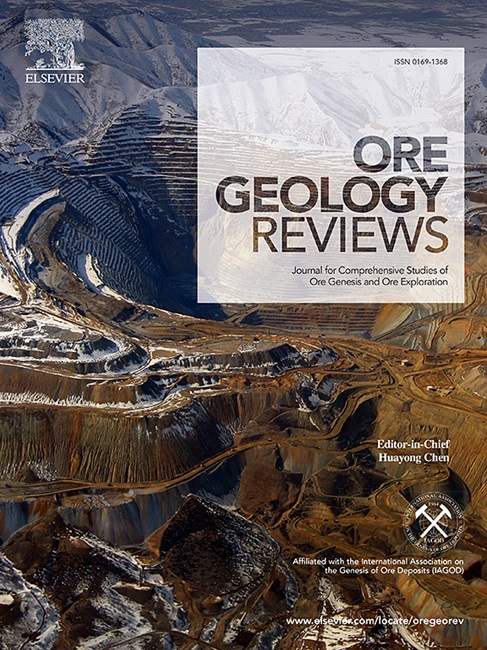大兴安岭南部茂登钼铋锡铜矿床黑云母地球化学特征及其成矿意义
IF 3.6
2区 地球科学
Q1 GEOLOGY
引用次数: 0
摘要
茅登钼铋锡铜矿床位于大兴安岭南段。在该矿床中发现了与矿石伴生的阿鲁宝格山杂岩体,由斑岩二长花岗岩(PMG)、花岗斑岩(GP)和碱长石花岗岩(AFG)组成。本研究提供了三种花岗岩亚型黑云母中主要微量元素的含量,旨在揭示不同岩性之间的成岩关系。阿鲁堡格格山杂岩中的黑云母具有岩浆成因。随着花岗岩亚型从PMG型和GP型到AFG型的变化,它们从碱性厌氧型到过铝型不等。同时,黑云母的组成也呈现出多样性,从鳞状黑云母到原橄榄石-锌walite。黑云母中总铝含量和Fe/(Fe + Mg)值由PMG - GP - AFG逐渐升高,岩浆演化程度渐进式。黑云母中Rb、Cs、Sn、W、Li含量增加,K/Rb和Nb/Ta比值下降,岩浆分异从PMG向AFG增强。从PMG到GP再到AFG,黑云母IV(F)值降低,IV(Cl)值升高,表明高程度的分级结晶导致F富集,流体析出导致残熔中Cl的消耗。从PMG到AFG,黑云母的Nb/Ta比值从12.8 ~ 33.5下降到2.76 ~ 3.66。研究表明,黑云母的分离结晶以及熔体与流体的强烈相互作用是造成阿鹿堡格格山杂岩中黑云母Nb/Ta比值下降的主要因素。与矿有关的花岗岩中高分级结晶、含cl流体的强烈析出和F元素的富集可能对茅登矿床的成矿作用起着至关重要的作用。本文章由计算机程序翻译,如有差异,请以英文原文为准。

Geochemical characteristics and their implications on mineralization of biotite from the Maodeng Mo-Bi-Sn-Cu deposit, southern Great Xing’an Range, China
The Maodeng Mo-Bi-Sn-Cu deposit lies in the southern part of the Great Xing’an Range. In this deposit, the ore-associated Alubaogeshan complex has been identified, which consists of porphyritic monzogranite (PMG), granite porphyry (GP), and alkali feldspar granite (AFG). This research provides the major-trace element concentrations in biotites from the three granite subtypes, with the intention of uncovering the petrogenetic relationships among different lithologies. The biotites in the Alubaogeshan complex have a magmatic origin. As the granitic subtypes change from PMG and GP, to AFG, they vary from alkaline anorogenic to peraluminous types. Simultaneously, the biotites exhibit a diverse array of compositions, spanning from lepidomelane to protolithionite-zinnwaldite. The total aluminum content and the Fe/(Fe + Mg) values in biotites rise gradually from PMG to GP and then to AFG, indicating a progressive degree of magmatic evolution. The trend of increasing magmatic differentiation from PMG to AFG is manifested by the decline in K/Rb and Nb/Ta ratios and the increase in contents of Rb, Cs, Sn, W and Li in biotites. From PMG to GP and then to AFG, a decrease in IV(F) value and an increase in IV(Cl) value in biotite suggest that a high-degree fractional crystallization resulted in F enrichment, and fluid exsolution caused Cl depletion in the residual melt. From PMG to AFG, Nb/Ta ratios of biotite drop from 12.8 to 33.5 to 2.76–3.66. This study indicates that fractional crystallization of biotite, as well as intense interaction of melt and fluid, is the main factor causing the decrease in biotite Nb/Ta ratios in the Alubaogeshan complex. The highly fractional crystallization, intense exsolution of Cl-bearing fluid, and enrichment of the F element in the ore-related granite may exert a crucial role in mineralization in the Maodeng deposit.
求助全文
通过发布文献求助,成功后即可免费获取论文全文。
去求助
来源期刊

Ore Geology Reviews
地学-地质学
CiteScore
6.50
自引率
27.30%
发文量
546
审稿时长
22.9 weeks
期刊介绍:
Ore Geology Reviews aims to familiarize all earth scientists with recent advances in a number of interconnected disciplines related to the study of, and search for, ore deposits. The reviews range from brief to longer contributions, but the journal preferentially publishes manuscripts that fill the niche between the commonly shorter journal articles and the comprehensive book coverages, and thus has a special appeal to many authors and readers.
 求助内容:
求助内容: 应助结果提醒方式:
应助结果提醒方式:


